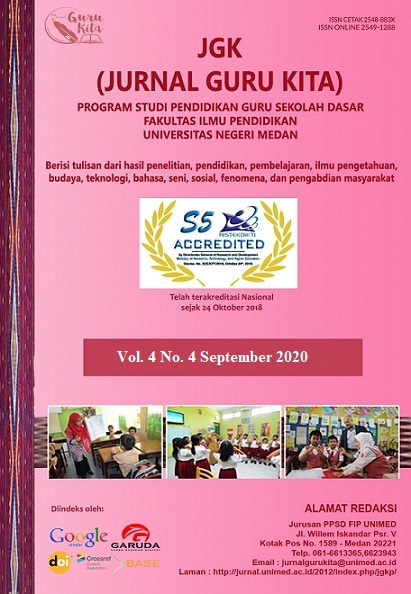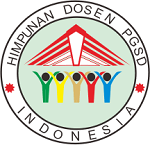TAKSONOMI BLOOM DAN FUNGSI KOGNITIF CARL JUNG DALAM PEMBELAJARAN MATEMATIKA
DOI:
https://doi.org/10.24114/jgk.v7i1.37867Keywords:
pembelajaran_matematika, taksonomi_bloom, kognitif_jungAbstract
Taksonomi Bloom dalam tujuan Pendidikan dibagi dalam tiga ranah (domain) utama yakni ranah kognitif, ranah afektif, dan ranah psikomotorik. Ketiga ranah ini masing-masing dibagi lagi ke dalam pembagian yang lebih rinci berdasarkan hierarkinya. Fungsi kognitif merupakan proses mental dalam memilih, menyimpan, mengolah, dan mengembangkan informasi yang diterima dari rangsangan eksternal. Carl Jung mengklasifikasikan fungsi kognitif dalam 4 kelompok, yaitu sensing, intuitive, feeling, dan thinking. Salah satu hasil dari proses kognitif otak proses mengelolah informasi ini diharapkan seseorang dapat menerima informasi (perceiving) dan membantu untuk memutuskan (judging). Ada persamaan dan perbedaan antara Taksonomi Bloom dan Fungsi Kognitif Carl Jung. Namun tujuan dari penelitian ini adalah merancang implementasi yang dapat menerapkan Taksonomi Bloom dan Fungsi Kognitif Carl Jung dalam pembelajaran Matematika.References
Agustin, N. S. (2022). Analisis Kematangan Karir Siswa Kelas XII MA Negeri 2 Kutai Kartanegara dengan Asesmen MBTI. Jurnal Pendidikan Tambusai, 6(1), 4487“4491.
Alifah, F. N. (2019). Pengembangan Strategi Pembelajaran Afektif. Tadrib: Jurnal Pendidikan Agama Islam, 5(1), 68“86. https://doi.org/10.19109/tadrib.v5i1.2587
Banich, M. T., & Compton, R. J. (2018). Cognitive neuroscience (4th ed.). Cambridge University Press.
Butar-Butar, J. L., & Simamora, I. (2022). Memperkenalkan Metode Investigasi Pemecahan Masalah Untuk Anak Sekolah Dasar Melalui Serial Anime Jepang Detective Conan. JURNAL CURERE, 6(1), 66“76.
Butar-Butar, J. L., Sinuhaji, F., Ginting, A. S., Barus, L. F. B., & Limbong, R. J. (2022). Penerapan Metode Investigasi Kelompok dalam Pembelajaran Sains di SD Swasta Letjen Jamin Ginting™s Berastagi. Jurnal Pengabdian UntukMu NegeRI, 6(1), 146“151.
Butar-butar, J. L., Sinuhaji, F., & Sembiring, J. A. B. (2019). Pendidikan Karakter Anak Dengan Metode Whole Brain Teaching Dalam Pembelajaran di Bimbingan Belajar Pencil Generation di Lingkungan V Simalingkar B Medan Tuntungan. Jurnal Pengabdian UntukMu NegeRI, 3(2), 178“185.
Effendi, R. (2017). Konsep revisi taksonomi Bloom dan implementasinya pada pelajaran matematika SMP. JIPMat, 2(1). https://doi.org/10.26877/jipmat.v2i1.1483
Epstein, S. (2010). Demystifying intuition: What it is, what it does, and how it does it. Psychological Inquiry, 21(4), 295“312. https://doi.org/10.1080/1047840X.2010.523875
Hartini, P., Setiadi, H., & Ernawati, E. (2021). Cognitive domain analysis (LOTS and HOTS) assessment instruments made by primary school teachers. Jurnal Penelitian Dan Evaluasi Pendidikan, 25(1), 16“24. https://doi.org/10.21831/pep.v25i1.34411
Hoque, M. E. (2016). Three domains of learning: Cognitive, affective and psychomotor. The Journal of EFL Education and Research, 2(2), 45“52.
Isaksen, S. G., Lauer, K. J., & Wilson, G. V. (2003). An examination of the relationship between personality type and cognitive style. Creativity Research Journal, 15(4), 343“354. https://doi.org/10.1207/S15326934CRJ1504_4
Istiqlal, M. (2019). Dukungan Kemampuan Intuitif Dalam Pemecahan Masalah Matematika. JIPMat, 4(2). https://doi.org/10.26877/jipmat.v4i2.3982
Lestari, M., Riyadi, R., & Usodo, B. (2015). Pengembangan Model Pembelajaran Berbasis Intuisi untuk Meningkatkan Kemampuan Berpikir Kreatif dalam Memecahkan Masalah Matematika Siswa Kelas X SMA Negeri 2 Sragen. Jurnal Pembelajaran Matematika, 3(7).
Magdalena, I., Elfrisca, D., Farida, & Hukmah, F. (2021). Pelaksanaan Taksonomi Bloom Dalam Pembelajaran Matematika Kelas 2 SDI Nurul Hasanah. Socio Humanus, 3(1), 145“153.
Magdalena, I., Fajriyati Islami, N., Rasid, E. A., & Diasty, N. T. (2020). Tiga Ranah Taksonomi Bloom dalam Pendidikan. Jurnal Edukasi Dan Sains, 2(1), 132“139. https://doi.org/10.36088/edisi.v2i1.822
Montgomery, D., Strunk, K., & Steele, M. (2017). Jungian typology as a holistic teaching strategy in higher education. 25(4), 10. https://doi.org/10.31235/osf.io/p39yc
Piirto, J. (2004). Understanding creativity. Great Potential PressInc.
Pogonowski, J. (1970). Intuitive explanations of mathematical ideas. Annales Universitatis Paedagogicae Cracoviensis | Studia Ad Didacticam Mathematicae Pertinentia, 10, 123“137. https://doi.org/10.24917/20809751.10.8
Puji, R. P. N., & Ahmad, A. R. (2016). Learning style of MBTI personality types in history learning at higher education. Economics, 3(6), 289“295. https://doi.org/10.27512/sjppi-ukm/ses/a13122016
Roediger III, H. L. (2013). Applying cognitive psychology to education: Translational educational science. Psychological Science in the Public Interest, 14(1), 1“3. https://doi.org/10.1177/1529100612454415
Saleh, M. (2022). Implementasi Pendidikan Karakter Di Sekolah Inklusi. Hikmah: Journal of Islamic Studies, 17(2), 101. https://doi.org/10.47466/hikmah.v17i2.198
Savic, M., & Kashef, M. (2013). Learning outcomes in affective domain within contemporary architectural curricula. International Journal of Technology and Design Education, 23(4), 987“1004. https://doi.org/10.1007/s10798-013-9238-8
Setiawati, F. A., Triyanto, A., & Gunawan, N. E. (2015). Implementasi MBTI untuk pengembangan karir mahasiswa: studi perbedaan tipe kepribadian pada mahasiswa bimbingan konseling. Jurnal Penelitian Ilmu Pendidikan, 8(2).
Shi, R., Shan, S., & Tian, J. (2007). Psychological Type and Undergraduate Student Achievement in Pharmacy Course in Military Medical University. Online Submission, 4(9), 20“24.
Simamora, I. (n.d.). Tingkat Kesiapan Mahasiswa PGSD Menjadi Seorang Guru Matematika Inovatif Berdasarkan Fungsi Kognitif Carl Jung. JGK (Jurnal Guru Kita), 6(2), 128“135. https://doi.org/10.24114/jgk.v6i2.30364
Sofyan, F. A., & Fihtanti, A. I. (2019). Implementasi Hots Pada Pembelajaran Matematika Sd/Mi Kelas 6. JGK (Jurnal Guru Kita), 4(1), 18“26. https://doi.org/10.24114/jgk.v4i1.16241
Sönmez, V. (2017). Association of Cognitive, Affective, Psychomotor and Intuitive Domains in Education, Sönmez Model. Universal Journal of Educational Research, 5(3), 347“356. https://doi.org/10.13189/ujer.2017.050307
Sriyana, S., & Winarso, W. (2018). Perilaku Belajar Efektif Terhadap Kemampuan Kognitif Psikomotorik Siswa Dalam Pembelajaran Matematika. IndoMath: Indonesia Mathematics Education, 1(2), 77. https://doi.org/10.30738/indomath.v1i2.2548
Susanto, E., & Mudaim, M. (2017). Pengembangan Inventori MBTI Sebagai Alternatif Instrumen Pengukuran Tipe Kepribadian. Indonesian Journal of Educational Counseling, 1(1), 41“52. https://doi.org/10.30653/001.201711.5
Sywelem, M., Al-Harbi, Q., Fathema, N., & Witte, J. E. (2012). Learning Style Preferences of Student Teachers: A Cross-Cultural Perspective. Online Submission, 1, 10“24.
Winarso, W. (2016). Assessing the readiness of student learning activity and learning outcome. Jurnal Pencerahan, 10(2), 74“88.
Downloads
Published
How to Cite
Issue
Section
License
Authors published with the JGK (Jurnal Guru Kita) agree to the following terms:
- Authors retain copyright and grant the journal the right of first publication with the work simultaneously licensed under a Creative Commons Attribution License (CC BY-SA 4.0) that allows others to share the work with an acknowledgment of the work's authorship and initial publication in this journal.
- Authors are able to enter into separate, additional contractual arrangements for the non-exclusive distribution of the journal's published version of the work (e.g., post it to an institutional repository or publish it in a book), with an acknowledgment of its initial publication in this journal.
- Authors are permitted and encouraged to post their work online (e.g., in institutional repositories or on their website) prior to and during the submission process, as it can lead to productive exchanges, as well as earlier and greater citation of published work. (See The Effect of Open Access)




























